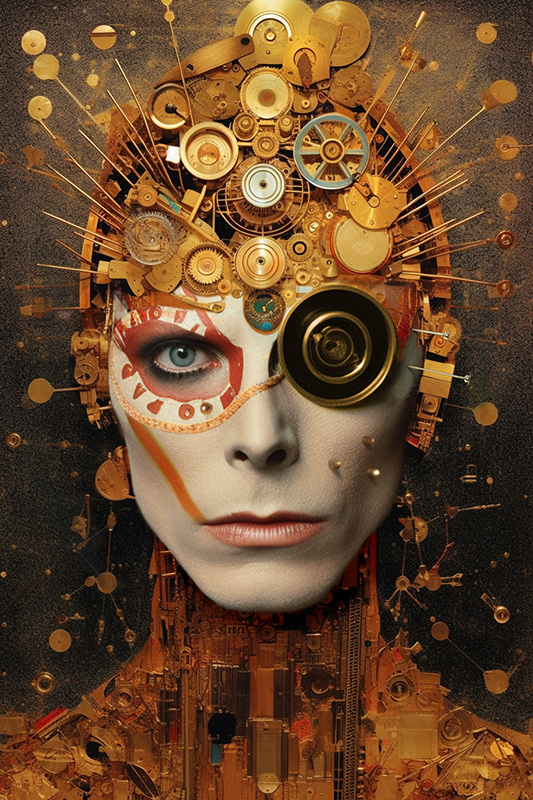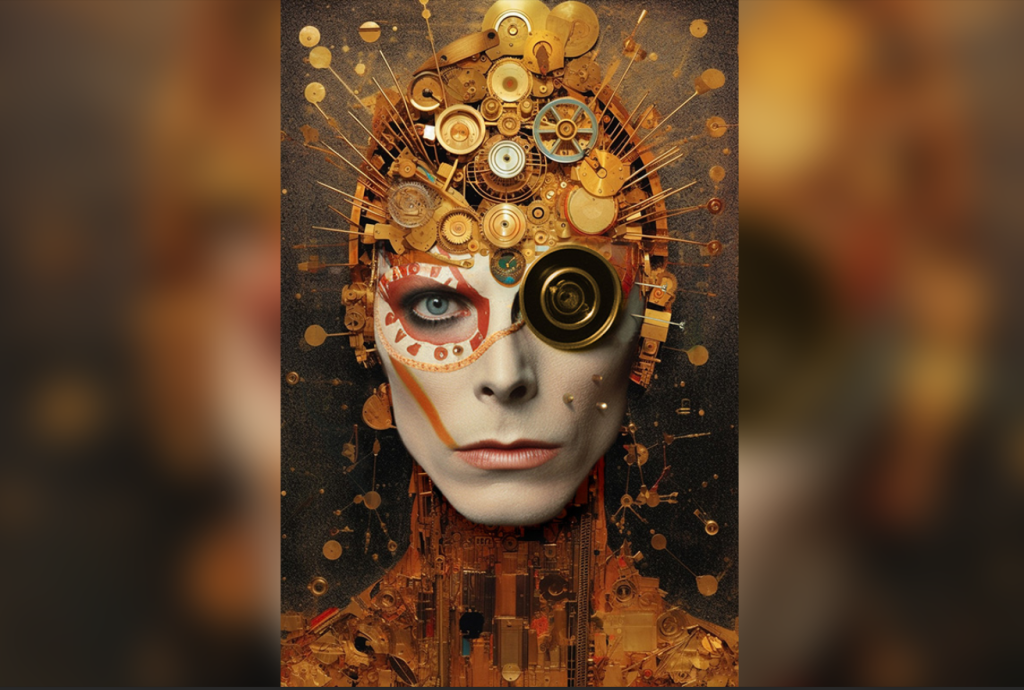Beloved for his groundbreaking blend of cutting-edge technology and art, Alex Mayhew creates captivating works that push boundaries of expression, and his work has been exhibited at prestigious institutions world- wide, including MOMI in New York and the National Museum in Singapore.
Now, the US based artist is bringing his unique new Bowie Bots to the StART art fair in London this October.
Mayhew first gained global recognition as the creator of a groundbreaking and hugely successful AR Art Exhibition at the AGO — an immersive digital intervention that piqued the interest of Apple CEO Tim Cook, who came for a private tour. Here, the unique creative unpacks the conceptual genesis of his visionary Bowie Bots, which explore personas the starman might have embraced through a series of cybernetic resurrections.
What does Bowie mean, or represent to you? What made you want to use him as a totem for immortality?
David Bowie, for me, represents the pinnacle of human creativity and spirit. He was an otherworldly figure who embodied everything inspiring about the human condition and epitomised the mesmerising potential of human creativity. Like many, I feel a profound sense of loss at his passing. This collection began with a personal plea: “No, don’t go. You have so much more to do.” It then evolved into a narrative where Bowie continues his journey through my imagination, an ongoing tribute that honours his legacy while celebrating his innate ability for fluid change and his defiance of conventional identities. Bowie’s creative approach is something I have always related to. His impact wasn’t confined to his music; his creativity was boundless, spanning music, performance, and even gender identity. He ventured into the unknown, famously advising:
“Always go a little further into the water than you feel you’re capable of being in. Go a little bit out of your depth, and when you don’t feel that your feet are quite touching the bottom, you’re just about in the right place to do something exciting.”
I feel a certain kinship with this approach. This collection also explores various existential questions related to religion, consciousness and technology.
What made you specifically want to explore robots or automata?
Historically, both Eastern and Western religions used advanced automata — early robots powered by clockwork — to create moving figures that encouraged belief in a particular god or religion. These automata created an illusion of greater power, drawing people into the fold as true believers. Many religions have promised spiritual immortality and an afterlife, but definitive proof has always been elusive. Ironically, technology now appears poised to deliver on these promises. We’re approaching the possibility of prolonging life or even uploading our consciousness to a computer, creating a form of digital immortality. Technology might soon offer us a kind of eternal life, transforming us into cybernetic angels.
How do you think the relationship between man and machine will evolve in our lifetime?
AI is an incredibly powerful tool with significant dangers and profound positive potential. Ethical concerns are prominent, as many AI systems have been trained on existing artists’ intellectual property without their consent, understandably tainting its reputation. This raises issues, especially when someone with little artistic ability can generate a ‘work of art’ instantly, exploiting years of other artists’ learning and honing their craft. As a trained artist myself, I understand how up- setting this could be. At first glance, from this point of view, AI-generated art could seem indefensible. However, I think it is important to look at this subject from multiple perspectives. If we set aside the potential legal issues and focus on the moral criticisms, isn’t building upon the whole pantheon of art what all artists do? None of us work in total isolation. Cultural evolution is about making our work better and more relevant in response to the rich history of time. We are all influenced by what has come before.
You have described yourself as an artist working in the multi-present — can you unpack what that means in relation to the Bowie series?

Working in the multi-present means creating art that is dynamic and responsive, engaging with the viewer in a deeply personal and multifaceted way. It’s about making art that aims to transcend the boundaries of time, space, and reality, inviting viewers to explore and connect on a visceral level. In the case of the David Bowie series, biographical and character exploration, my desire to pay tribute to the great man with fictional narrative development, and exploration of concepts around consciousness, religion, and technology all inform the development and content of the work. I constantly ask myself which combination of mediums and technologies can elevate the experience further. In this sense, how the work is experienced becomes as integral to the art as what is being experienced. For example, as the viewer moves around works like ‘Golden Angel Deluxe,’ they will see the work respond with a glamorous sparkle shimmering across the work from the hand-applied micro glitter and diamond dust. The effervescent re- active finish makes the work feel alive in both an angelic and cybernetic way, harking back to the futuristic glam of Bowie’s early 70’s era. Similarly, ‘The Change Maker: Blinker’ uses kinetic lenticular technology to reflect Bowie’s defiance of confinement. Each piece responds differently to light and human presence. The observer’s interaction with the art initiates its response, and this dynamic interplay elevates the narrative elements that are revealed.
StART art fair. 9-13 October, The Town Hall, KX, London.
- Sandy Cross



